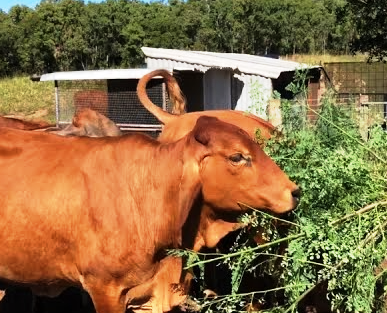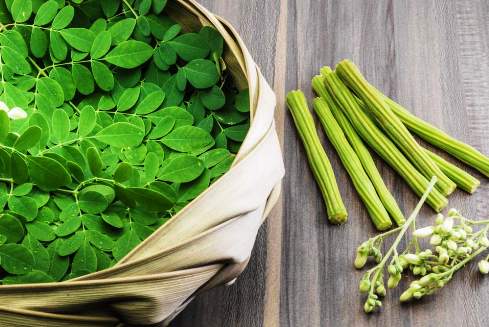मोरिंगा ओलीफेरा अनुपूरण के माध्यम से डेयरी मवेशियों में प्रजनन और उत्पादक क्षमता में सुधार
In tropical livestock production, underfeeding is a critical issue due to limited feed quantity and quality, resulting in reduced milk yields and incomes for farmers, especially in the dry season when natural pastures lack nutritive value. Dairy farming in tropical regions is complex, intertwined with economic and social dimensions. Conventional concentrates are expensive, limiting their use.


Alternative, low-cost supplements, cultivable by farmers year-round, are needed to enhance nutritional levels and boost the economy in small-scale dairy production. This highlights the necessity of finding cost-effective solutions to improve dairy farming in tropical climates.
Under good cultivation practices, such as proper soil preparation, adequate irrigation, fertilization, and pest control, drumstick plantations can indeed yield significant quantities of pods and leaves per acre per year. The yield of drumstick pods can range from 18 to 20 tonnes per acre per year and leaves can range from 25 to 32 tonnes per acre per year under optimal conditions.
In addressing the challenges of suboptimal reproductive performance and escalating veterinary costs in livestock production, it's essential to explore alternative feed resources. Moringa (Moringa oleifera), drought-tolerant tree rich in crude protein and devoid of inhibitors like tannins, trypsin, and amylase, presents a promising solution.
Despite its potential, Moringa remains underappreciated in animal nutrition. Its high dry matter yield and nutritional content make it a viable protein source for livestock, potentially improving reproductive efficiency and overall productivity. By harnessing the benefits of Moringa supplementation, farmers can mitigate the economic impacts of poor fertility while enhancing the sustainability of livestock production systems.
Moringa Supplementation
Moringa leaf meal supplementation offers a convenient solution to address fluctuations in Moringa production throughout the year. While fresh Moringa is readily available, its production varies seasonally. Moringa leaf meal, however, can be produced during periods of high yields and stored for use during the dry season when quality feed resources are limited.
Its production requires affordable and feasible technology, making it accessible to small-scale farmers. Moringa foliage, including branches, twigs, and leaves, can be harvested from crop plots or live fences, sun-dried, and processed into leaf meal.
To obtain Moringa foliage, including branches, twigs, and leaves, they can be harvested from pure crop plots or live fences using a machete. Subsequently, the harvested foliage is spread out on a black plastic sheet placed on the ground for sun-drying.
The drying process typically takes around 72 hours, after which the dried leaves can be separated from the branches and twigs through simple threshing. The remaining small dry leaves are then manually crushed or ground by hand to obtain Moringa leaf meal. This process yields approximately 1 kg of Moringa leaf meal from every 10 kg of fresh material.
While drying preserves its nutritive value, ensiling has been found to be more efficient in retaining anti-oxidative activity, making it a suitable preservation method for moist crops.
Nutritional Potential of Moringa Oleifera
Moringa trees are renowned as "miracle trees" due to their rapid growth, low irrigation and fertilizer needs, and impressive resilience after harvesting. The leaves, highly valued for their nutrient richness and minimal harmful components, stand out among livestock feeds.
Compared to alternatives like soybean, cottonseed cake, and range grasses requiring significant watering, Moringa is more water-efficient. Moringa oleifera is a nutritional powerhouse, boasting abundant levels of essential fatty acids, vitamins, minerals, and crude protein.
Its nutritional superiority is evident, offering substantial protein, calcium, vitamin C, vitamin A, iron, and potassium. Additionally, it provides phenolic compounds, oxycaroteniod, and essential minerals like copper, chromium, manganese, phosphorus, magnesium, zinc, and vitamin B-complex. Moreover, Moringa's fat content, predominantly composed of unsaturated fatty acids, surpasses that of typical woody plant fodder.
In dairy animals, fatty acids (FAs) play vital roles in various biological processes and are considered essential nutrients and chemical compounds. Triglycerides, a type of FA, serve as precursors for generating crucial energy-producing metabolites, while oocytes and embryos utilize them as an energy source for differentiation, development, and immune system function.
FAs also contribute to reproductive processes. However, polyunsaturated fatty acids (PUFAs) face challenges such as susceptibility to lipid oxidation, limited gastrointestinal tract absorption, and instability during processing and storage, leading to loss of nutritional value and biological impacts. Plants' metabolic processes produce anti-nutritional factors that can hinder digestion and lead to malnutrition.
These factors, including saponins, tannins, lignin, and lectins, serve as crucial indicators for determining the suitability of plant leaves for animal feed. Moringa oleifera leaves contain only small amounts of saponins (4.7–5%) and fiber content (5.9%), particularly lignin, which imparts a bitter taste. However, these quantities are insignificant and do not cause adverse effects on animals.
Antioxidant property of Moringa
The antioxidant activity of Moringa is not solely attributed to polyphenols. Alongside direct antioxidants, Moringa leaves contain indirect antioxidants, contributing to its effectiveness in preventing and treating various health disorders such as inflammation, hypertension, and bacterial and viral infections.
These include thiocyanates, which modulate oxidative stress by inducing phase II detoxifying enzymes. Moringa leaves exhibit remarkable storage stability without compromising their nutritional value. Rich in protein, M. oleifera is highly resistant to rumen degradation, making it a popular choice for fodder.
Dietary supplementation with dried Moringa leaves has been shown to dose-dependently increase milk yield in dairy cows. While drying preserves its nutritive value, ensiling has proven to be a more efficient preservation method, particularly in retaining anti-oxidative activity.
Ensiling, a preservation technique suitable for moist crops, ensures the long-term viability of Moringa leaves as a valuable dietary supplement.
Effect of Moringa Oleifera on reproductive and productivity of Dairy Cattle
Low libido and poor semen quality significantly impact bulls' reproductive efficiency, leading to postponed conception, increased culling rates, reduced calf weaning weights, and prolonged calving seasons, resulting in economic losses.
The nutritional status of bulls influences sperm quality, production, gonadotropin secretion, and sexual development. Hormones like follicle-stimulating hormone (FSH) and luteinizing hormone (LH) stimulate seminiferous tubules and Leydig cells, affecting sperm and testosterone production.
Essential amino acids such as methionine and cysteine are crucial for spermatogenesis, while arginine, linolenic acid, vitamins A, C, and E, zinc, and selenium are also essential. Zinc, in particular, plays a pivotal role in testosterone production by stimulating Leydig cells in the testes.
Additionally, bioactive substances like saponins, alkaloids, flavonoids, ferulic acid, and chlorogenic acid found in herbs contribute to enhancing sexual activity. Moringa oleifera contains these substances, making it beneficial for improving reproductive health in bulls.
The nutrient-rich composition of Moringa leaves holds the potential to significantly increase milk production in dairy cows. With their high protein content and essential amino acids, Moringa leaves effectively support lactation and milk synthesis, resulting in elevated milk yields.
Moreover, feeding Moringa leaves to dairy cows enhances nutrient utilization and absorption, ensuring the animals receive vital nutrients for optimal health and performance. The diverse array of vitamins and minerals present in Moringa leaves further contributes to overall nutrient uptake. Additionally, Moringa leaves contain bioactive compounds that can modulate hormonal pathways involved in estrus expression.
By promoting hormonal balance, Moringa leaf feeding enhances the synchronization and intensity of estrus cycles in dairy cows, leading to improved breeding outcomes. Furthermore, the balanced nutrient composition and phytochemical content of Moringa leaves positively impact ovarian function, stimulating follicular development and supporting the ovulation process, thereby ensuring optimal fertility and reproductive performance.
Moreover, Moringa leaf feeding has been linked to improvements in metabolic hormone regulation in dairy cows. The bioactive compounds in Moringa leaves, such as flavonoids and phenolic, exert regulatory effects on hormones involved in metabolism, insulin sensitivity, and energy balance, thereby promoting overall metabolic health in cows.
Furthermore, the antioxidants and bioactive compounds present in Moringa leaves bolster the immune system of dairy cows, reducing oxidative stress and inflammation, and enhancing resilience against diseases.
Overall, Moringa leaves offer comprehensive support for reproductive health in dairy cows, leading to better estrus expression, higher conception rates, and reduced calving intervals, ultimately enhancing the overall reproductive efficiency of the herd.
Moringa leaves have been studied for their potential to increase milk yield in livestock, particularly in dairy cows. In India, where dairy farming is a significant agricultural activity, several studies have explored the impact of supplementing cow diets with Moringa leaves on milk production.
A study conducted by researchers at the Tamil Nadu Veterinary and Animal Sciences University (TANUVAS) in India investigated the effect of supplementing Moringa leaves in the diet of lactating cows. The study found that incorporating Moringa leaves at 150 grams per day per animal resulted in an increase in milk yield by approximately 15 to 20 percent.
Another study conducted by scientists at the National Dairy Research Institute (NDRI) in India evaluated the impact of feeding Moringa leaves to lactating cows. The study reported that supplementing Moringa leaves in the diet of cows led to an increase in milk yield by around 10 to 15 percent.
These studies indicate that supplementing the diet of dairy cows with Moringa leaves can lead to a significant increase in milk yield in India, typically ranging from 8 to 20 percent.
However, it's important to note that the exact impact may vary depending on factors such as the quality of Moringa leaves, the feeding regimen, and the overall management practices on the farm.
Conclusion
In conclusion, supplementation with Moringa oleifera leaf meal offers promising benefits for enhancing nutrient digestibility, milk yield, and reproductive performances in dairy cows during early lactation.
The rich nutritional content, bioactive compounds, and health-promoting properties of Moringa leaf make it a valuable supplement for optimizing the health and productivity of dairy herds.
Nonetheless, incorporating Moringa leaf supplementation into dairy cow diets holds great potential for improving farm profitability, sustainability, and animal welfare in the dairy industry.
Authors:
Anjali, Megha Pande, S. Mahajan, Suresh Kumar, S. Saha, A.S. Sirohi, and N. Chand
Cattle Physiology and Reproduction
ICAR-Central Institute for Research on Cattle
Post Box No.17, Grass Farm Road, Meerut Cantt. -250001, U.P., India.
Email:
